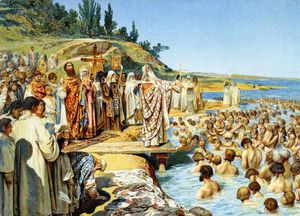Difference between revisions of "Baptism of Rus'"
(Adding image) |
(ro) |
||
| Line 29: | Line 29: | ||
[[pt:Batismo da Rus']] | [[pt:Batismo da Rus']] | ||
| + | [[ro:Încreștinarea rușilor]] | ||
Latest revision as of 09:32, June 25, 2024
The Baptism of Rus' refers to the seminal event of the mass baptism of the residents of Kiev in 988 as Grand Prince Vladimir accepted Orthodox Christianity as the religion of his lands. The event, as recorded in the Primary Chronicles, has been considered the turn point for the introduction of Christianity among the eastern Slavs.
Contents
History
Introduction of Christianity into the lands of the Slavs began at least a century before the great event in Kiev. Traditionally, the missionary brothers Ss Cyril and Methodius are credited with bringing the eastern form of Christianity to the Slavs, in their own language, in the 860s, although the southern Slavs had already known Christianity. Among the eastern Slavs, whose ruling princes, the Rus, were descended from the Varangian (Norse) chieftains/traders, introduction of Christianity appears to have occurred in several stages.
As early as 867, Patr. Photius of Constantinople advised the other Orthodox patriarchs that members of the Rus, who had been baptized by his bishops, had become enthusiastic Christians. As the Primary Chronicle and other sources noted the Rus of the ninth century remained staunch pagans, and the outcome of the missionary efforts of Photius’ bishops is not clear. Constantine VII and later Byzantine historians, including John Skylitzes and John Zonaras, continued to maintain a story of Christianization of the Rus, including enumeration of Orthodox sees among the Rus, that otherwise has not been evident. These sources also are silent on the baptism of the Rus in the late tenth century.
The Primary Chronicle notes that a sizable part of the population of Kiev was Christian in the mid tenth century although noting the ruling princes continued following pagan customs. The Chronicle describes the actions in the mid tenth century of the ruling regent of Kiev, Princess Olga of Kiev, who visited Constantinople with a priest Gregory. While it is unclear when and where she was baptized, she became an Orthodox Christian and attempted to convert her son, Svyatoslav. But, he remained a stubborn pagan to his death in 972. His son and successor, Yaropolk I, appeared to be conciliatory towards Christianity and may have entertained visiting Christian missionaries.
After Yaropolk’s death in 980 and the ascension of his brother Vladimir as the ruling prince, Vladimir led a pagan reaction to Christianization efforts. This revitalization of pagan worship failed, however. By the mid 980s Vladimir realized the need to adopt the true religion. In 987, as reported in the Primary Chronicle, and after consulting with his boyars (knights), Vladimir dispatched envoys to study the religions of neighboring nations. Upon returning, the envoys reported their impressions, noting their objections to the religions of the Muslims, Jews, and German Christianity, while expressing the joy of the festive ritual in the cathedral Hagia Sophia in Constantinople.
Concurrently, Emperor Basil II in Constantinople approached Vladimir for aid suppressing a revolt of some of his generals. In response, Vladimir sent troops to help Basil put down the revolt. As part of their earlier agreement, Vladimir was baptized with the Christian name Basil, and followed his baptism by a marriage to Basil II’s sister, Anna Porphyrogenta.
Having accepted Christianity, Vladimir then called the people of Kiev to baptism in the Dnieper River - the iconic event of the Baptism of Rus'. First, Vladimir’s twelve sons and many boyars were baptized. Then, the next day all the residents of Kiev were called to the river, where the Orthodox priests completed the sacrament of baptism. In the following days the ceremony was observed throughout the realm of Vladimir, Grand Prince of Kiev and Novgorod.
By the act of baptizing his subjects, Vladimir signaled the acceptance of Orthodox Christianity as his state religion. Also, it was this event that Russia, the lands of the Rus and the Slavic east, entered into the greater Christian world as part of the Hellenic Christian heritage. This event had the further meaning, as noted by Fr. John Meyendorff:"For the Byzantines, the ‘baptism of the Russians’ signified their integration into the [Byzantine Roman] empire itself."
Source
- Ed. Tessa Clark, The Russian Chronicles, Thunder Bay Press, 2001 ISBN 1-57145-577-9
Reference
- J. Meyendorff, Byzantium and the Rise of Russia, St Vladimir’s Seminary Press, Crestwood, New New York, 1989 ISBN 0-88141-079-9
